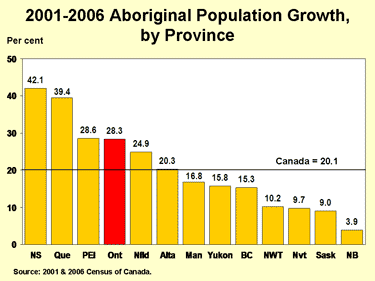Aboriginal Peoples of Ontario






This factsheet looks at the 2006 Census data on the Aboriginal peoples of Canada released by Statistics Canada.
Ontario’s Aboriginal Population
- In the 2006 Census, 242,495 people self-identified as Aboriginal persons (that is, North American Indian or First Nations people, Métis or Inuit) in Ontario. This represented 2% of the province’s total population, an increase from 1.7% in 2001.
- In 2006, the majority of the Aboriginal population was North American Indian, representing 65.3% (down from 69.9% in 2001). The Métis followed at 30.4% (up from 25.7% in 2001), and the Inuit at 0.8% (up from 0.7% in 2001).
- Between 2001 and 2006, Ontario’s Aboriginal population grew faster than the non-Aboriginal population, increasing 28.3%, nearly five times faster than the 6.2% rate of growth for the non-Aboriginal population. Several factors may account for the fast growth of the Aboriginal population, both demographic and non-demographic (e.g. more individuals choosing to identify themselves as an Aboriginal person).
- Of the three Aboriginal groups, the fastest gains in population between 2001 and 2006 occurred among the Métis and the Inuit with growth rates of 52.3% and 48%, respectively. The North American Indian or First Nations people increased by 19.6%.
One in Five Aboriginal people Lived on Reserves
- In 2006, a fifth of all Aboriginal peoples in Ontario lived on reserves, with another 18.3% in rural areas. Of those on reserves, nearly all (99%) were North American Indian, virtually unchanged from 2001, and representing around 30% of the North American Indian population.
- The Métis and the Inuit lived mainly in urban areas at 72% and 82%, respectively.
The Aboriginal Population is Relatively Younger
- The Aboriginal population is younger than the non-Aboriginal population. More than a third (35.7%) of the Aboriginal population consists of children and teenagers aged 19 and under, compared with a quarter (25.1%) for the non-Aboriginal population.
The Aboriginal Population Across Canada
- In 2006, over half (53.5%) of Canada’s Aboriginal population lived in three provinces: Ontario, British Columbia and Alberta.
- Ontario, the most populous province, is also the province with the largest Aboriginal population. One in five of the country’s Aboriginal peoples (21%) lived in Ontario in 2006.
- BC had the second-largest Aboriginal population (17% of Canada), followed by Alberta (16%).
Aboriginal Population Growth Fastest East of Manitoba
- Most Aboriginal people lived in Ontario and the West, but the fastest increase in the last five years occurred east of Manitoba.
- Between 2001 and 2006, the number of people identifying themselves as Aboriginal increased 42% in Nova Scotia, 39.4% in Quebec, 28.6% in PEI, 28.3% in Ontario, and 24.9% in Newfoundland and Labrador.
- Among regions with a high concentration of Aboriginal people in the population, the fastest increases were in Manitoba (16.8%) and the Yukon (15.8%).
The Territories and Prairie Provinces have the Highest Concentration of Aboriginal Population
- In 2006, the highest concentrations of Aboriginal population were found in the Territories and in the Prairies.
- Nunavut had the highest proportion of Aboriginal people in its population (85%) in 2006, followed by the Northwest Territories (50%) and the Yukon (25%).
- Among the provinces, Manitoba and Saskatchewan have the largest proportion of Aboriginal people at 15.5% and 14.9%, respectively.
- All provinces east of Manitoba had less than 3% of Aboriginal people in their populations, with the exception of Newfoundland and Labrador which had almost 5%.
- In Ontario, Aboriginal people accounted for 2% of the total population in 2006.
- About one in 10 Aboriginal people (26,575) in Ontario lived in the Toronto Census Metropolitan Area (CMA), representing 0.5% of the total population of the CMA.
Contact Paul Lewis (416) 325-0821 / Victor Caballero (416) 325-0825.